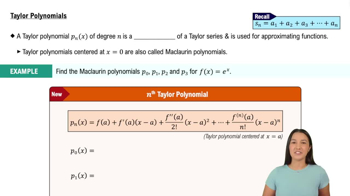If n is a known positive integer, for what value of k does the following hold:
Table of contents
- 0. Functions7h 54m
- Introduction to Functions16m
- Piecewise Functions10m
- Properties of Functions9m
- Common Functions1h 8m
- Transformations5m
- Combining Functions27m
- Exponent rules32m
- Exponential Functions28m
- Logarithmic Functions24m
- Properties of Logarithms36m
- Exponential & Logarithmic Equations35m
- Introduction to Trigonometric Functions38m
- Graphs of Trigonometric Functions44m
- Trigonometric Identities47m
- Inverse Trigonometric Functions48m
- 1. Limits and Continuity2h 2m
- 2. Intro to Derivatives1h 33m
- 3. Techniques of Differentiation3h 18m
- 4. Applications of Derivatives2h 38m
- 5. Graphical Applications of Derivatives6h 2m
- 6. Derivatives of Inverse, Exponential, & Logarithmic Functions2h 37m
- 7. Antiderivatives & Indefinite Integrals1h 26m
- 8. Definite Integrals4h 44m
- 9. Graphical Applications of Integrals2h 27m
- 10. Physics Applications of Integrals 3h 16m
- 11. Integrals of Inverse, Exponential, & Logarithmic Functions2h 34m
- 12. Techniques of Integration7h 41m
- 13. Intro to Differential Equations2h 55m
- 14. Sequences & Series5h 36m
- 15. Power Series2h 19m
- 16. Parametric Equations & Polar Coordinates7h 58m
12. Techniques of Integration
Integration by Parts
Problem 8.7.74
Textbook Question
71-74. Deriving formulas Evaluate the following integrals. Assume a and b are real numbers and n is a positive integer.
74. ∫xⁿ arcsin(x) dx (Hint: integration by parts.)
 Verified step by step guidance
Verified step by step guidance1
Step 1: Recall the formula for integration by parts: ∫u dv = uv - ∫v du. Choose u and dv wisely. For this integral, let u = arcsin(x) and dv = xⁿ dx. This choice is made because the derivative of arcsin(x) simplifies nicely, and xⁿ dx can be integrated easily.
Step 2: Compute du and v. Differentiate u = arcsin(x) to get du = (1 / √(1 - x²)) dx. Integrate dv = xⁿ dx to get v = (xⁿ⁺¹ / (n + 1)).
Step 3: Substitute u, v, du, and dv into the integration by parts formula: ∫xⁿ arcsin(x) dx = uv - ∫v du. This becomes (arcsin(x) * (xⁿ⁺¹ / (n + 1))) - ∫((xⁿ⁺¹ / (n + 1)) * (1 / √(1 - x²)) dx).
Step 4: Simplify the first term and focus on the second integral. The first term is straightforward: (arcsin(x) * xⁿ⁺¹) / (n + 1). The second integral requires further simplification and potentially substitution techniques to handle the √(1 - x²) term.
Step 5: Consider substitution for the second integral. Let z = √(1 - x²), which implies x = sin(θ) and dx = cos(θ) dθ. Rewrite the integral in terms of z or θ to simplify further. Continue solving step by step until the integral is fully evaluated.
 Verified video answer for a similar problem:
Verified video answer for a similar problem:This video solution was recommended by our tutors as helpful for the problem above
Video duration:
3mPlay a video:
Was this helpful?
Key Concepts
Here are the essential concepts you must grasp in order to answer the question correctly.
Integration by Parts
Integration by parts is a technique used to integrate products of functions. It is based on the product rule for differentiation and is expressed as ∫u dv = uv - ∫v du, where u and dv are chosen parts of the integrand. This method is particularly useful when one part of the product is easily integrable while the other is easily differentiable.
Recommended video:

Integration by Parts for Definite Integrals
Arcsine Function
The arcsine function, denoted as arcsin(x), is the inverse of the sine function, defined for values in the range [-1, 1]. It returns the angle whose sine is x. Understanding the properties and behavior of the arcsine function is crucial when integrating expressions involving it, as it often appears in calculus problems related to trigonometric identities.
Recommended video:

Properties of Functions
Polynomial Functions
Polynomial functions are expressions of the form f(x) = a_n x^n + a_(n-1) x^(n-1) + ... + a_1 x + a_0, where a_i are constants and n is a non-negative integer. In the context of integration, polynomials are straightforward to integrate, and their behavior can significantly influence the complexity of the integral when combined with other functions, such as arcsin(x).
Recommended video:

Taylor Polynomials

 8:30m
8:30mWatch next
Master Introduction to Integration by Parts with a bite sized video explanation from Patrick
Start learningRelated Videos
Related Practice
Multiple Choice
26
views
